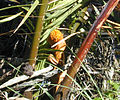Nypa fruticans
| Nipa subsp. var. | Nipa Palm, Mangrove Palm, Nipah palm | |||||||||||||||||||||||||||||||||||||||||||||||||||||||
|---|---|---|---|---|---|---|---|---|---|---|---|---|---|---|---|---|---|---|---|---|---|---|---|---|---|---|---|---|---|---|---|---|---|---|---|---|---|---|---|---|---|---|---|---|---|---|---|---|---|---|---|---|---|---|---|---|

|
|
| ||||||||||||||||||||||||||||||||||||||||||||||||||||||
| ||||||||||||||||||||||||||||||||||||||||||||||||||||||||
Nypa fruticans, known as the Attap Palm (Singapore), Nipa Palm (Philippines), and Mangrove Palm or Nipah palm (Indonesia, Malaysia), Dừa Nước (Vietnam), Gol Pata (Bangladesh), Dani (Burma) is the only palm considered a mangrove. This species, the only one in the genus Nypa, grows in southern Asia and northern Australia. Fossil mangrove palm pollen has been dated to 70 million years ago. Fossilized nuts of Nypa dating to the Eocene epoch occur in the sandbeds of Branksome, Dorset, and in London Clay on the Isle of Sheppey, Kent,[1] testifying to much warmer climatic conditions in the British Isles at that time.
The Nipa palm has a horizontal trunk that grows beneath the ground and only the leaves and flower stalk grow upwards above the surface. Thus, it is an unusual tree, and the leaves can extend up to 9 m (30 ft) in height. The flowers are a globular inflorescence of female flowers at the tip with catkin-like red or yellow male flowers on the lower branches. The flower yields a woody nut, these arranged in a cluster compressed into a ball up to 25 cm (10 in) across on a single stalk. The ripe nuts separate from the ball and are floated away on the tide, occasionally germinating while still water-borne.
Nipa palms grow in soft mud and slow moving tidal and river waters that bring in nutrients. The palm can be found as far inland as the tide can deposit the floating nuts. It is common on coasts and rivers flowing into the Indian and Pacific Oceans, from Bangladesh to the Pacific Islands. The plant will survive occasional short term drying of its environment. Nypa fruticans is an endangered species in Singapore.
| Standard Cyclopedia of Horticulture |
|---|
|
Nipa (native name in Molucca). Palmaceae. One species of palm widespread along tidal rivers and estuaries, Ceylon to the Philippines and Australia, the great leaves much used hi thatching, and the fruit edible. Trunks or rootstocks prostrate, gregarious: Lvs. pinnatisect, 10-30 ft. long, from the ends of the rootstocks; lfts. numerous, rigid, plicate, lanceolate, long-acuminate, 2-3 ft. long: fls. moncecious, in an erect inn. springing from the rootstock; male fls. small, in catkin-like lateral branches of the spadix, stamens 3; female fls. larger, in terminal globose heads, the carpels 3: fr. large and spherical (as large as a man's head), comprised of many carpels or drupes 4-6 in. long. Toddy is extracted from the spadix, and from this product other materials (as sirup, sugar and vinegar) are made. Kernel hard and white, edible. N. fruticans, Wurmb., is a most useful plant in the thatch-making in the Philippines, but it is probably not cult, to any extent. It has been intro. in S. Fla.
|
Cultivation
Propagation
Pests and diseases
Varieties
Gallery
References
- Standard Cyclopedia of Horticulture, by L. H. Bailey, MacMillan Co., 1963
External links
- w:Nypa fruticans. Some of the material on this page may be from Wikipedia, under the Creative Commons license.
- Nypa fruticans QR Code (Size 50, 100, 200, 500)



